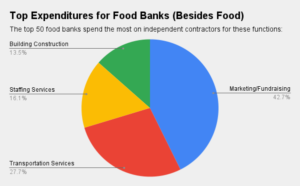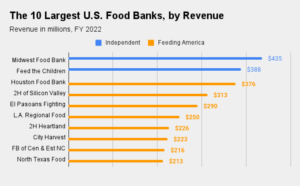Welcome to the Food Bank News ranking of largest 100 food banks.
[For our latest information on the scope of the food banking sector, please see our 2021 Directory of the Top 300 Food Banks.]
While there are many ways for a food bank to be “tops,” our ranking is by revenue. It’s our first stab at trying to make sense of the nationwide food-bank network, which has grown over 50 years from a single organization into a vast and critical part of the health and well-being of millions throughout the United States.
Food banks have never been more important to our country’s welfare than over the last seven months, as the economic distress caused by Covid-19 has created a doubling, tripling and even quadrupling of demand at food banks and pantries. With federal benefits failing to meet the need, food banks have become a lifeline for millions.
With so much at stake, Food Bank News is compelled to better understand the organizations that make up the increasingly indispensable charitable food system. If the goal is to fight hunger, we want to know more about the army that’s waging the battle.
Revenue offers one avenue of understanding. Revenue has the benefit of being a standard measure reported annually to the government, creating a common baseline. Revenue is also an indication of the resources a food bank has on hand to support programs to solve hunger.
With resources comes influence. Food banks have already demonstrated their might in distributing massive amounts of food. When the impact of Covid-19 settles into a new normal, food banks will continue to wield enormous power in their ability to help people via the programs they decide to fund and promote.
Ultimately, it’s the programs that Food Bank News is most interested in highlighting and celebrating. Once we know which food banks make up the Top 100 (or Top 10 or 50 or 20), we can more closely examine their programs to feature the ones proving most effective in fighting hunger.
We hope that our Top 100 list will be a starting point for driving greater information-sharing and collective action. Food banks can compare their programs and goals against other similarly-sized organizations, as well as across the broader industry, to benchmark the scope and progress of their activities.
With greater knowledge of industry-wide practices, food banks can also more easily collaborate with other organizations, exchange best practices and prioritize their own activities. As Food Bank News shares stories about winning food-bank programs, we hope to accelerate the sector’s overall response to ending hunger.
Food banks already do so much good in the world. Food Bank News is aiming to help them do even more.
Like what you’re reading?
Support Food Bank News









